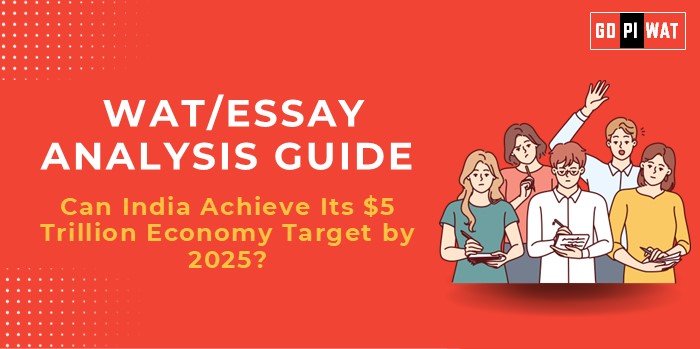📋 WAT/Essay Analysis Guide: Can India Achieve Its $5 Trillion Economy Target by 2025?
⏱️ Updated Essay Planning Framework
- Time Allocation (30 Minutes):
- 📝 Planning: 5 minutes
- ✍️ Writing: 20 minutes
- 🔍 Review: 5 minutes
- Word Count Distribution (500 Words):
- Introduction: 60-70 words
- Body Paragraphs: 350-375 words
- Conclusion: 60-70 words
💡 Introduction Techniques for Essays
- Statistical Hook:
“India’s GDP of $3.73 trillion in 2023 positions it as the fifth-largest economy globally, but achieving the $5 trillion target by 2025 requires unprecedented growth and structural reforms.”
- Contrast Approach:
“While India’s economic growth outpaces major economies, challenges like unemployment and inflation highlight a dichotomy that could hinder the $5 trillion ambition.”
- Global Comparison Introduction:
“China achieved a $5 trillion GDP in 2010 with double-digit growth, providing a benchmark for India’s economic ambitions. Yet, India’s path faces unique challenges and opportunities.”
📊 Structuring the Essay Body
🏆 Achievements
Highlight key accomplishments in digital economy growth, infrastructure expansion, and FDI inflows. For example:
⚠️ Challenges with Comparative Analysis
Discuss barriers like unemployment, fiscal deficit, inflation, and rural-urban disparities. For example:
“India’s unemployment rate of 7.8% highlights the need for labor-intensive industries, unlike China’s manufacturing boom that supported its $5 trillion milestone.”
🚀 Future Outlook
Suggest forward-looking strategies, leveraging sectors like renewable energy, AI-driven industries, and robust trade partnerships. For example:
📄 Concluding Effectively
- Balanced Conclusion:
“India’s journey to a $5 trillion economy by 2025 is a mix of commendable achievements and structural hurdles. Success lies in bridging the gaps in infrastructure, employment, and fiscal discipline while capitalizing on its digital economy and global partnerships.”
- Global Comparison Conclusion:
“Drawing lessons from nations like China and the US, India must tailor its economic policies to its unique demographic and geopolitical landscape, ensuring inclusive and sustainable growth.”
🌟 Recommendations for Sustainable Progress
- 📜 Policy Interventions:
- Simplify taxation policies like GST to enhance ease of doing business.
- Provide fiscal incentives for MSMEs and startups in emerging sectors.
- 💻 Enhancing Digital Infrastructure:
- Extend the BharatNet program to cover 100% rural penetration by 2025.
- Invest in cybersecurity to safeguard digital transactions and data.
- 📦 Boosting Export Competitiveness:
- Diversify exports beyond IT and pharmaceuticals, exploring markets in green technology and manufacturing.
✍️ Refined Sample Short Essays
- Balanced Perspective:
“India’s $5 trillion ambition is ambitious but achievable with focused reforms. Robust digital infrastructure and export growth provide a strong foundation, but fiscal discipline and inclusive growth are critical to overcoming barriers like unemployment and inflation.”
- Solution-Oriented Approach:
“To achieve its $5 trillion target, India must prioritize digital inclusivity, expand manufacturing under PLI schemes, and foster global trade through strategic FTAs. Balancing inflation control and fiscal spending will be crucial.”
- Global Comparison Approach:
“While China reached the $5 trillion GDP mark through manufacturing and exports, India’s strategy must leverage its unique strengths—digital innovation and demographic advantage—to realize its economic vision.”
📚 Expert Insights and B-School Connections
- Insights for Internships and Projects:
- Analyze sectoral policies that drive economic growth.
- Study how digital transformation aids rural financial inclusion.
- Real-World Applications:
- Explore case studies of countries that achieved significant GDP milestones.
- Examine public-private partnerships fostering industrial growth.
- Interview Question Samples:
- How does India’s digital economy contribute to its GDP target?
- What lessons can India learn from China’s manufacturing-driven growth model?


